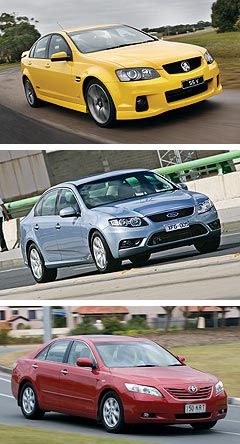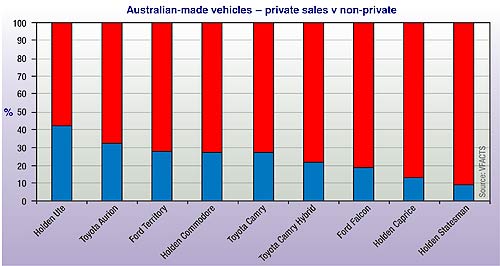Make / Model Search
News - General News - SalesFleet sales still loom large over local industryTake me home: 42 per cent of Holden Utes are sold to private buyers. Holden leads ‘big three’ in private sales, but fleet vehicles still dominate21 Sep 2010 FOR every new motor vehicle sold to a private customer in Australia so far this year, another has gone to a fleet customer – business, government or rental company – and usually at a healthy discount. Of sales to so-called non-private customers, roughly half of the vehicles have come from the ‘big three’ local car-makers, with vehicles split to varying degrees between their own locally made products and imports from overseas partners. The local car-makers will tell you that fleet sales, despite thin-to-invisible profit margins, give them considerable benefits via economies of scale in manufacturing, profit on spare parts and, for their dealers, servicing.  From top: Holden Commodore, Ford Falcon, Toyota Camry. From top: Holden Commodore, Ford Falcon, Toyota Camry.Privately, though, they and their dealers wish more of their sales were to private customers, from whom they stand a better chance of wringing an up-front return on every vehicle, even if only through accessories and the like. Profit is usually fatter on the up-spec models preferred by private buyers, too. When GM Holden launched its VE Commodore in 2006, part of the goal was to lift the top-selling large sedan’s appeal to both private buyers and so-called ‘user-chooser’ business lease customers who, although counted as business fleet numbers, are effectively private purchasers. Ford, too, was looking to raise the mix of up-market Falcons when its current FG model arrived, to help the bottom-line. So, how do the local car-makers fare in the private/non-private buyer split? Starting with the three biggest-selling locally made cars – Holden Commodore, Ford Falcon and Toyota Camry – it is clear that none even get close to a 50/50 split of the general market. Almost three-quarters of Commodore and Camry sales – 73 per cent for both, to be exact – are made to fleet buyers, with just 27 per cent finding homes with ordinary domestic motorists this year. But at the Blue Oval, private sales are even weaker, with just 19 per cent of Falcons parked in private garages, and 81 per cent going to non-private owners. Ford has sold almost 22,000 Falcons to fleets, compared with Holden’s 27,000 Commodore sedans, Sportwagons and Utes, and yet Commodore outsells Falcon by 50 per cent overall. Clearly, Holden is winning more of the hearts and minds of private buyers, as the company intended when it launched the VE. However, the picture is skewed the other way when we look at a couple of derivatives of these two vehicles. The private share of Ford’s Falcon-based Territory volume is 28 per cent, reflecting its appeal to families, while the private share of Holden’s long-wheelbase Caprice is just 13 per cent, reflecting its role as a limo for both commercial chauffeurs and governments. Top dog for private buyers in Australia is Holden’s Ute, at 42 per cent. And a good many more of those vehicles are no doubt sold as business vehicles to tradies, farmers and the like – effectively private sales. The Toyota Aurion – the reskinned, up-market stretched version of the Camry – is next best, with a 32 per cent private clientele. Camry Hybrid manages only 22 per cent, with government buyers – particularly the Victorian government – providing a large slice of the sales support for that vehicle, unsurprisingly after investing heavily to woo its production to Australia. That low percentage of private appeal would be a disappointment to Toyota, which had banked on a larger slice of private, green-tinged motorists getting their cheque books out to save money at the bowser. That buyer split, however, is line-ball with the private uptake of Toyota’s other hybrid car, the Prius – about 24 per cent. And that brings us to overall fleet sales by the big three, including their imports. Toyota is overwhelmingly the biggest supplier of non-private vehicles in Australia – 87,540 in the eight months to the end of August, compared with Holden’s 51,829 and Ford’s 44,197. However, it is Ford that sells the greatest percentage of its volume to non-private buyers – 68 per cent, compared with Toyota’s 62 per cent and Holden’s 57 per cent. In Toyota’s case, the fleet appeal of its imported vehicles – Corolla, Yaris, RAV4, Tarago, HiLux and LandCruiser, in particular – no doubt raises the non-private element of its sales. Holden turns out to be the closest to achieving a 50/50 split of the overall market, possibly because it has not been pushing fleet sales as hard as the others after suffering a severely dented bottom line in the GFC. It will be interesting to see if that changes once Holden begins local production of its Cruze small car in 2011, with pressure to maximise factory throughput.  |
Click to shareGeneral News articlesResearch General News Motor industry news |









Facebook Twitter Instagram